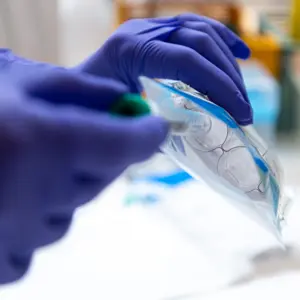Labels
For the shipping and transportation of medical goods, various packaging regulations apply. Most shipping materials must be equipped with specific labels and stickers.
Packaging According to the P(I)650 Guideline
For the transport of biological substances, categories A and B such as patient samples and veterinary materials, legal requirements apply (see ADR and/or IATA guidelines), including the proper labeling of these materials. The packaging instruction P(I)650 is a mandatory packaging standard for both road and air transport. In our assortment, you will find special stickers that can be used internationally for air transport.
Dry Ice Label for Transport
To ship dry ice, you must use an ADR (Accord européen relatif au transport international de marchandises Dangereuses par Route) or IATA (International Air Transport Association) sticker. The ADR is the pan-European agreement for the international transport of dangerous goods by road, and the IATA governs air transport. The corresponding labels are mandatory when transporting dangerous substances. Throughout the European Union, ADR labels are required on trucks, containers, or drums when transporting dangerous goods. When shipping dry ice, it is essential to use a dry ice label with class 9. The corresponding UN number is 1845.
Void Labels
Void labels are security stickers to prevent tampering with secured transport goods. DaklaPack offers the Security Seal sticker as a void label. When an attempt is made to remove the Security Seal stickers, they become damaged, making it immediately apparent if the seal has been tampered with. Void labels are crucial for the shipment of important medical research. They can also be used for other transport where sealing is important.
Labels for Dangerous Substances
DaklaPack offers a wide range of labels specifically designed for labeling dangerous substances. These labels comply with applicable national and international regulations, such as UN guidelines and ADR requirements. They feature clear symbols, pictograms, and texts to indicate the nature of the dangerous substance, as well as instructions for safe handling and transport. Proper labeling ensures the safety of recipients and transport personnel and compliance with laws and regulations.
Extra Services from DaklaPack
Labels and stickers may seem like a small part of safely shipping medical goods, but at DaklaPack, we recognize that correct and complete labeling is crucial.
Additionally, they often serve as an informational tool to communicate strict requirements to a supplier, which is common when dealing with medical goods. All in all, it is a precise and complex process that requires careful attention to detail. Therefore, DaklaPack is pleased to offer more than just packaging solutions, including safe transport and storage of goods.
Thanks to our position as a strategic partner of PostNL, we can always offer you a reliable and efficient shipping solution. Do you need advice on your medical shipments? Our specialists are ready to work with you to find the best approach. We are happy to help you find suitable medical transport that meets all strict requirements.
Frequently Asked Questions

Order your labels and stickers at DaklaPack
For questions about labels and stickers, you can reach us at (201) 630-6480 or info@daklapack.nl. You can also contact us via the contact page, and we will get back to you as soon as possible.
In addition to providing labels and stickers, DaklaPack also stocks P620 and P650 packaging, EPS boxes, sample transport solutions, and shipping materials. Can't find what you're looking for? DaklaPack can also create custom medical packaging besides standard stock deliveries. This includes printing medical packaging with your logo, special instructions, or other features.






